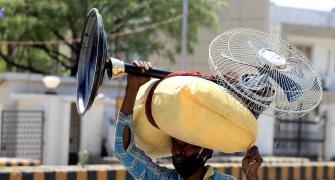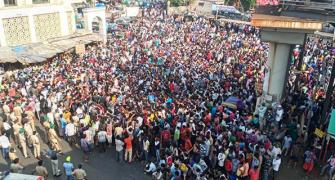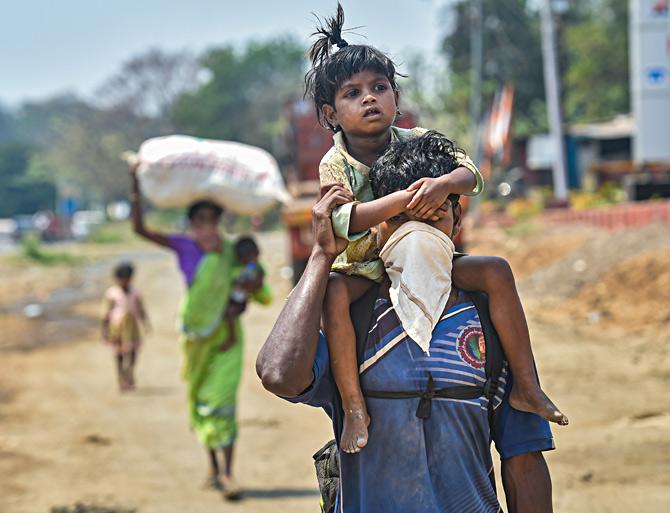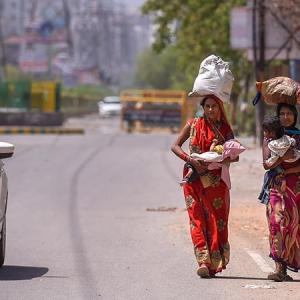'For them life is very difficult since there has been no universalisation of PDS.'
'And let's understand that there are people who need ration instead of cooked meals.'

Shweta Damle, founder member of Habitat and Livelihood Welfare Association, an NGO, is actively engaged in providing migrant labourers with rations during the lockdown.
"A majority of migrant workers live in slums; slums are scarce in amenities as it is and to top it, being outsiders they are treated with suspicion and are not welcome in the community," Damle tells Rediff.com's Prasanna D Zore.
What is the situation of migrants in Mumbai and Maharashtra right now?
They are going through a very difficult time.
In Maharashtra, specifically there has been no universalisation of ration (the public distribution system).
Food is a priority right now, ration is a priority, but that has not happened.
With the lockdown extended, they are finding it difficult to earn money.
Some of them have got wages for March, but they have got no word from their employers (about their salaries for April).
I am talking about the workers who are working and living on site in industrial estates and industries across Maharashtra.
And they are not daily wage workers; they are a separate group.
These are people who are working in small industries in the periphery of this city, the industrial hubs that are outside the city.
Then there are other people who are into construction work, but they are not associated or they are not registered under the construction workers's boards.
These are all migrant workers among whom there are also daily wage workers, there are head loaders and hawkers too.
Many of these are not organised. For them life is very difficult since there has been no universalisation of PDS (public distribution system). And let's understand that there are people who need ration instead of cooked meals.
They are not used to what the government is providing them at some places and by non-profit organisations. They are not used to eating khichdi every day.
Many of the migrants are from northern India where rotis are consumed as staple and their tastes are also different.
Every day consumption of khichdi is something which is not palatable.
Apart from that, a majority of these migrant workers live in slums; slums are scarce in amenities as it is and to top it, being outsiders they are treated with suspicion and are not welcome in the community.
Many of these are young, male migrant workers and there is a fear (about them). Even in many housing societies when there are a couple of bachelor men living in, people are a little wary of them for various reasons.
These young migrants too are facing the same problem. For such people amenities become even more scarce.
When they are working they go out, they use public amenities (like sulabh shauchalayas or bathrooms), but when they are in the lockdown where they are not allowed to move on that's the time it's becoming all the more traumatising for them because availability of water for them in the communities is less. Similarly, toilet usage is less.
I have known many people in Behrampada (a large slum colony outside the Bandra railway station on the east side) or Indira Nagar Pipeline (outside Bandra railway terminus on the east side) who used to go to the (Bandra) terminus to use the amenities their for bathing, for toilets.
So, it is juts not food, but sanitation and hygiene are also emerging as serious problems for the migrant communities living in slums.
What's the scale of this problem? How many migrants are stuck in Mumbai, Maharashtra, who want to go home or don't get enough ration?
This data is very difficult to get. First, for the primary reason that there is no proper documentation of these people.
If they were documented in some way, if the shops and establishments were registered of small enterprises (where these people work), they wouldn't have been so invisible. We don't know the quantum of them.
Where are these migrants concentrated in Mumbai or Maharashtra?
A simplistic answer would be where livelihoods are available.
But you will see a lot of migrant workers in Bandra especially engaged in tailoring; if you move a little ahead and go to Kherwadi (also in north west Mumbai) you will see a lot of migrant workers from Rajasthan, who are naka workers (daily wagers who stand at the nooks and corners of roads where contractors come and take them to different parts of the metropolitan Mumbai for doing jobs) engaged as masons in the real estate sector.
If you go towards the northern suburbs of Mumbai like Pathanwadi in Goregaon ( also in north west Mumbai) you will find this area full of construction workers from Rajasthan.
Then if you look at the Kurla (north east Mumbai) region, the migrants here work in the scrap industry.
Since a lot of construction activities were happening in New Mumbai, you will see a lot of migrant workers associated with construction.
If you go to Bhiwandi, Kalwa and Dahanu you will see a lot of industrial workers. Similarly, you will see a lot of industrial workers around Chakan in Pune.
The migrant workers from Pune and Aurangabad may not be directly employed in the automobile industry (both the regions in Maharashtra are major auto hubs with major automobile manufacturing plants belonging to national and multinational companies) but indirectly the unorganised sector supports the organised sector.
For instance, a lot of autorickshaw drivers from the unorganised sector ply passengers who come to work in the organised sector.
So, there's a symbiotic relationship between the organised and unorganised sectors.
What are the main demands of this floating migrant population?
Their main demand is they want to be repatriated to their homes across India. The state government for its part is just providing these people food.
Do you think the miserable conditions of migrant workers will deteriorate going ahead now that the lockdown has been extended?
Yesterday (April 14), the sudden gathering of thousands of migrants was not something which was planned.
Yesterday's gathering could also have been because a lot of people might have purchased (railway) tickets thinking the lockdown will get over on this day (April 14).
This is what I have heard from one of the labour union leaders. He told me that these people had purchased tickets for their return to their homes thinking that the lockdown would be lifted after April 14.
The other thing is that most of them are living on rent. But the ground reality is something different.
There is a possibility that many of them will be evicted (if they fail to pay rents. This fear too must be very dominant among the migrant population).
Today (April 15) one group of industrial workers from Dombivali (a town near Mumbai) called me to tell me that they want to register a case because their employers had not paid them wages for March, and they have been abandoned (by their employers).
Since I am not a lawyer, I connected them with a lawyer and they are going to take it ahead.










